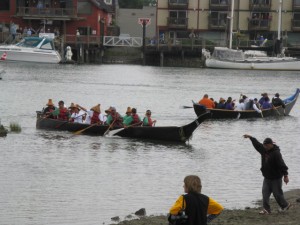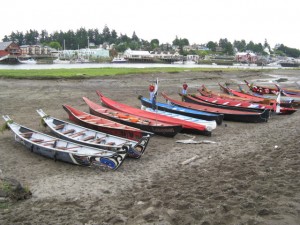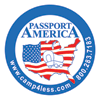Paddle to Swinomish Canoe Journey
July 24–31, 2011
Photos of LaConner and the Swinomish Canoe Journey
I arrived at the Swinomish tribal grounds on Sunday afternoon, July 24th. The Swinomish tribe is the host of Journey this year. Every year a different tribe hosts the event. Next year the Squaxin tribe will be the host tribe. The Swinomish tribe did an exceptional job preparing for the event and it showed in so many ways. They cleared land and made a large canoe family campground so tents could be set up for the various tribes and people attending the event. I found a spot to park in and set up my camper for the week. It was all dirt roads with a little gravel, and when I left on Sunday night, my camper was covered in dust and dirt from the cars, shuttles, trucks, etc.
The campground had lots of port a potties which they called Honey Buckets, there were also handwashing stations. I was really impressed that they had 3 tractor trailer trucks with portable showers, and 2 with washing machines and dryers, soap and laundry detergents were also supplied and the showers were closed for cleaning 4 hours each day. There was no charge to use anything on tribal property.
On Monday morning, it was raining and the canoes were not due to arrive until high tide about 3 p.m. In the afternoon, while it was cold and rainy, we went to the watch the boats come ashore, here are the pictures I took during my time in northern Washington and at the canoe journey.
So, I took a shuttle to LaConner which is a quaint town across the river with lots of shops and directly on the water. I found a great bakery and bought some scones with berries, boy was it delicious. After walking around for a while, I decided to head towards the parking lot to get the shuttle back to the tribal grounds. It was raining and cold, and it turned out to be a long walk to the pickup spot. I wasn’t sure I was going to make it, but I finally did.
My friend Bear and others were setting up their vendor booths, so I helped a little. Then when the canoes were beginning to arrive I went down to the waterfront to watch. It was cold and raining and still there were hundreds of people cheering on the canoes as they arrived. Since it was high tide, the channel was filled with water. At low tide, it was just mud. The Swinomish tribe passed out tote bags with the Paddle to Swinomish wording and logo, along with their theme wording, Loving, Caring, and Sharing Together. They also gave out large plastic water bottles with the logo. The paddlers arriving also received this gift.
It was interesting to hear the various songs sung in each canoe, each in their native language, with a beat and or drum so that it helped the paddlers keep rhythm. Each canoe family also had a support boat that had their tents, supplies, food, and other paddlers so they could switch out when someone got tired. They had wake up calls at about 3 a.m. They ate, broke camp and were back in the canoes about 5 or 6 a.m. And they paddled again until late afternoon, and arrived at another spot, did protocol for arrival, and then left again the next day. Some of the tribes were on the rivers for 4 weeks, some for shorter times.
I met people from various parts of Alaska, Canada, Oregon, and Washington. When I met someone that was a paddler, I asked them what they will remember most about their journey. The responses varied, but basically it was learning about the others in the canoe, being about to enjoy nature and calmness paddling, learning about their strength and stamina, etc. One young gal told me that last year there were 2 canoes next to each other and a whale came up between them and the paddlers were able to pet it. She showed me a picture on her phone. It was amazing, there were 2 canoes about 3 feet apart, and between them was a whale coming straight up out of the water about 3 feet, and people were leaning over the sides of the canoe and petting it. I was amazed that the whale came up between them and didn’t capsize the canoes. It just fit in the space between them. What a cool experience to have had. Others told me about dolphins that swam with them, or seals that would surface and play with the canoe. I’m guessing they were curious but also may have liked playing in the wake of the canoes and maybe the songs and drumbeat interested them.
I volunteered on Tuesday and they gave us a volunteer t-shirt, and also as a volunteer they gave us soup for lunch and beverages. It really was nice to have a place to come in and get out of the weather which some days was cool and rainy, and other days got some sunshine and maybe 70 degrees.
The Swinomish tribe provided breakfast every day (Tuesday – Sunday) from 7 to 10 a.m. They also provided dinners every day. Elders were served 4-6 p.m. Everyone else from 6-8 p.m. Other tribes and also sponsors helped to pay for all the food, and some other tribes provided food as well. There was no cost for the meals. I heard that the first dinner served over 8,000 meals. We ate great meals for dinner. One night it was salmon cooked on the grill, salad, potatoes, dessert, and tea or water. There were so many pallets of water all around the food tent and protocol tent. One night we had halibut tacos with potato salad, one night hamburgers and hotdogs, another night tacos, and the final night we had grilled salmon, dungeness crabs, potato salad, dessert, and salad. It was so delicious.
I did not hear an official count, but there must have been more than 10,000 people there. There were about 60 different tribes listed to perform protocol ceremonies. Some tribes had 1 canoe, some had 2 or 3 canoes. He number of paddlers in each canoe varied depending on the size of the canoe.
Protocol was set up so that about 10 tribes performed each night. They did not give time limits, and some tribes took several hours each and they went each night until the protocol list was completed. Some nights, I could still hear the ceremonies at 3 or 4 a.m. If they did not finish that night, or really early morning, they started again at 10 the next morning and went into the early morning again. I think that every day they started out behind. One person that told me they were going to perform at 10 a.m. On Friday, was moved to Saturday at 10 a.m. And they actually performed at 8:30 p.m. On Saturday. They were from the Aleutian Islands in Alaska and it was very interesting. The lead woman in the tribe had a booth in the vendor area and I had been talking with her all week so it was a treat to get to watch her tribe perform their protocol. When she told their tribal stories she told one about when a young man and woman decided they wanted to marry, the young man would move into the girls family for 2 years, no sex she said. He would have 2 years to prove that he could hunt and fish to show her family that he could be a good provider for her and their future family. If he did not do well then they would not get married, and the girl would look for another suitor. The men had hats and when they showed their hunting ability they would have seal whiskers on the back of their hats, if they didn’t have any, it meant they were not good hunters or were too young yet to hunt.
Seeing the various tribal regalia was really interesting. There were some similarities such as the color and coastal designs, but there were also differences in some of the styles and dances. Many of the canoe songs were also similar, and the languages they spoke in were so different. They spoke in their language and also in English so everyone would know their story behind the songs and dances. Many of the dances were sacred and not to be filmed nor photos taken. I didn’t take any pictures during the protocol ceremonies I watched since I felt it was just to be experienced by those present and I wasn’t sure which ones were okay, except when it was announced. So to be safe, I didn’t take any. I will tell you that it was so moving to experience. I didn’t watch all the protocols, but I did see many of them. I even cried during some when the people telling the stories of their tribe told of some of the trials and tribulations they and their tribal members experienced. Some talked about the damage that drugs and alcohol did in their tribe. I could tell they lost many people to those things. They talked about how the culture has been changing from the ways of their ancestors. Their ancestors hunted for their food, ate more healthy, etc. and they didn’t have the diseases that are now affecting tribal members such as diabetes, cancer, etc. That now more fast food is eaten, and it’s affecting health issues, as does drugs and alcohol.
There is good news, many of the younger generations want to learn the old ways and traditions. Canoe Journey has been a positive experience and helps the younger generations want to learn more about their heritage and ways. Tribal communities also work together and share knowledge and experience. They help and support each other. During this week, a tribal member died. One of the tribes put a blanket on the field and asked for donations to help the family. Lots of people came down and put offerings and about $847 was raised for the family to help with expenses.
During each tribes protocol, they introduced their tribe, told where they were from, a little about themselves, then presented songs, stories, and dances. When they were almost finished, they asked the Swinomish host tribe for permission to take their canoe and leave to travel home. They were given permission, and both tribes exchanged gifts such as drums, blankets, cedar hats, etc. The elders of each tribe, the youth, paddlers, drummers, and others who were instrumental to their journey were gifted and honored. The ceremonies were really touching to watch, even though sometimes there were long. It could take 45 minutes for the gifting portion of the ceremony. The main ceremony was at least 2 hours long, some longer. Sometimes a few tribes were together for their ceremony. Perhaps one was stronger in dance, and so they teamed up with a tribe that was stronger in song. Or perhaps it’s because they were smaller and were neighbors. Some tribes had LOTS of people in their ceremony, and others less. It was really touching and fun to watch the really young kids dancing in the arena, or even singing. I’m talking about 2 or 3 years old. They were so adorable in their regalia trying to be like the adults. There were also many teens in the ceremonies.
I’m really glad I got to have the Canoe Journey experience. It’s been such a rewarding experience from watching the canoes come ashore, to volunteering, helping my vendor friends in their booths, meeting and talking with people I didn’t know, learning about the traditional Native American ways and ceremonies, and watching protocol. I even got to meet a guy named Rudy who was selling cherries and apricots that were picked the day before from his families orchard nearby. They were the best cherries, grown without chemicals, and eaten the day after being picked fresh. Every time I passed Rudy’s booth, I stopped and talked with him.
I did get in lots of walking between my campsite and the protocol, food, and vendor tents. They did have shuttle vans and golf carts available and I also used them many times. It was a 10 minute walk from my campsite to the grounds where everything was held. At night, it did get cold, it was in the 50’s or low 60s every morning when I woke up. Since there was no electricity hookups, I could not run my generator at night, almost everyone in the large campground sections were in tents. There are some nights that kids were shooting off fireworks at 1 a.m.
The view from the hill where I was camped was spectactular. There mountains were in the distance over the fields in the foreground. When it was clear sky I could see snow capped mountain in the distance. Mount Baker could be seen on a clear day, it’s a snow covered glacial mountain that stands above the other mountains in the range.
The Canoe Journey Paddle to Swinomish has been a life changing experience, not only for me, but for many others that were in attendance and/or participated. So many of us volunteered and it gave us a common bond and an introduction when we talked with each other. We wore bright yellow orange shirt and could easily identify each other. There was also a tribal dentist that I met. He gave away toothbrushes and dental floss at the information booth. He also gave free checkups and fluoride treatments to children both in his office, and he also walked through the family campground to talk with and treat the children. He also had a great sense of humor and great personality.
There was a pathway from the road to the waterfront where the canoes came ashore, and also where 3 large cedar hat pavilions were constructed in a park for this event with 4 totem poles. In order to preserve land where they knew tribal ancestors were buried, and where some land was sacred, they built a path and along the path were traditional plants with small signs telling the name of the plant in their native language and English, also what it was used for. They also had larger informational signs telling about their crafts, the canoe history, culture, etc. It was really nice to walk the path and read about the history and culture of the tribe and their community and how it’s changed and what it was like years ago.
I feel very blessed that I was able to have this experience and witness such a special coming together of tribes and people from all parts of the country, and many from other countries. I met people from Tennessee, Belgium, New Zealand, Alaska, and so many more places.



